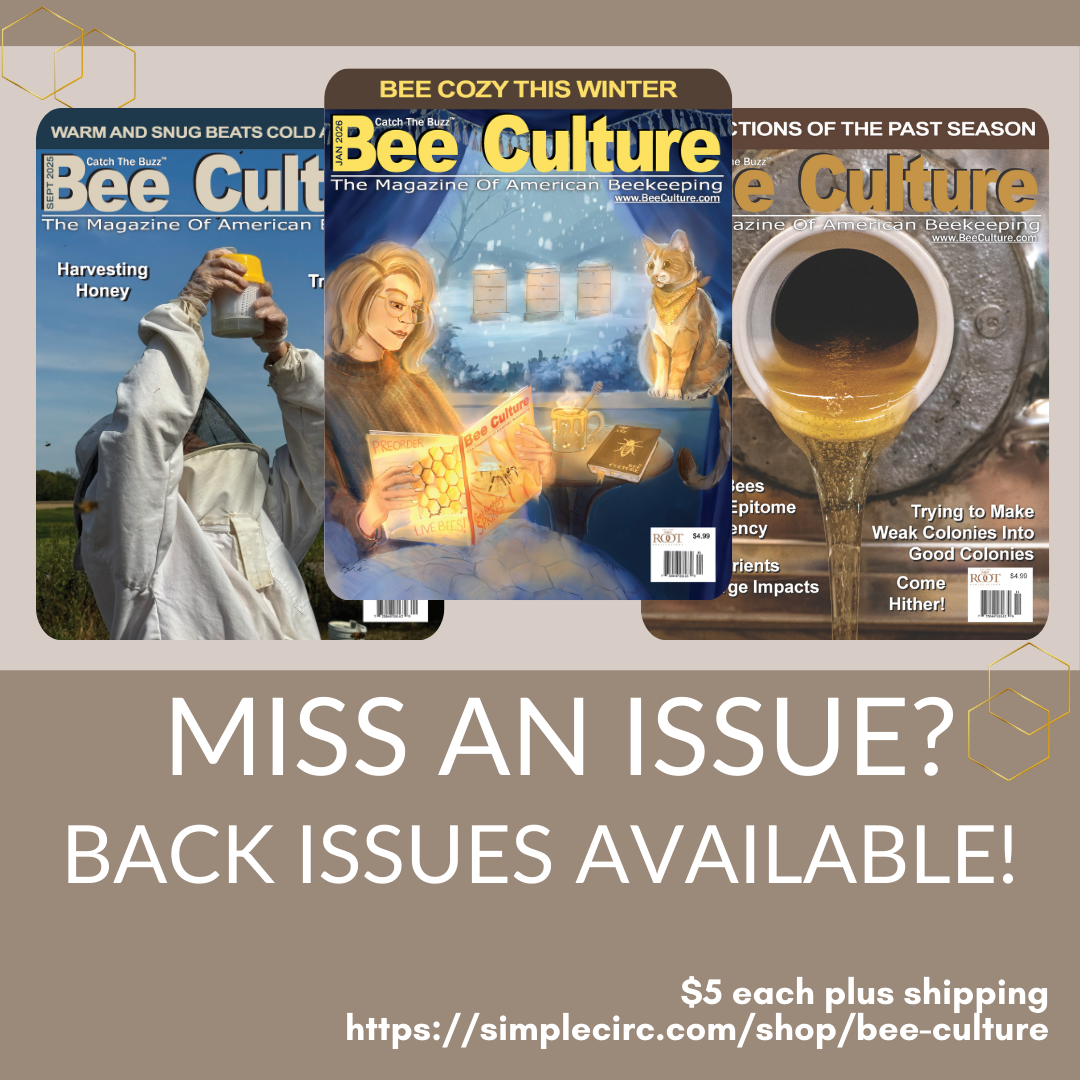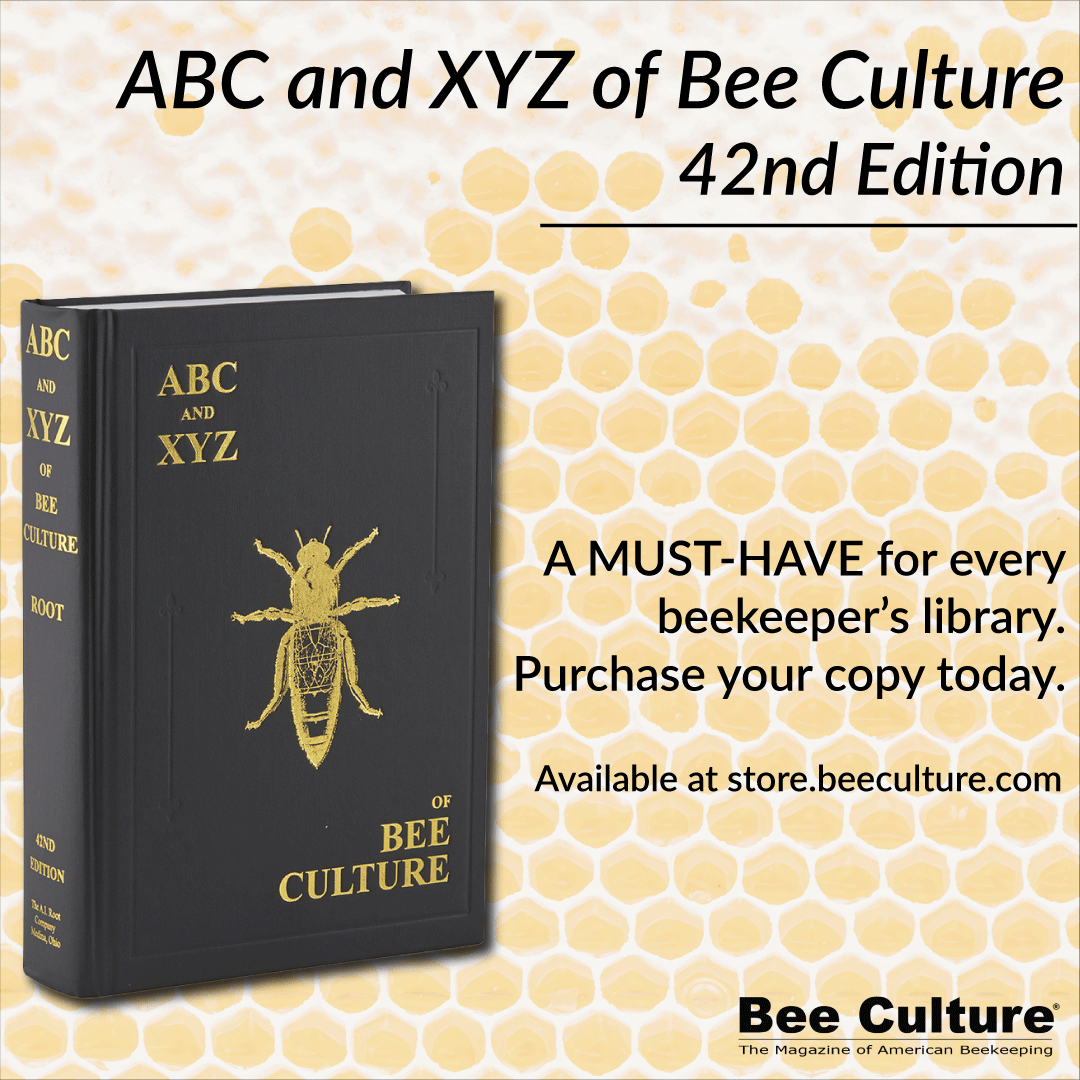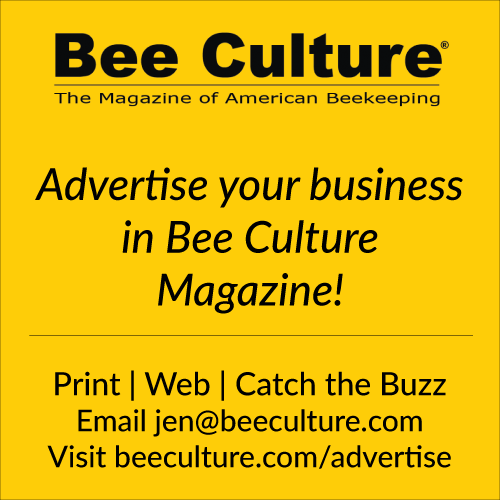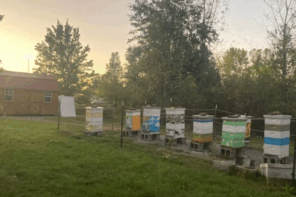America’s Father Of Practical Beekeeping
by David Edwards
In 1853, Lorenzo Langstroth of Massachusetts and Moses Quinby of New York published their books on beekeeping – “Langstroth on the Hive and the Honeybee–a Beekeeper’s Manual” and “Mysteries of Bee Keeping Explained”, by Quinby, both books going through the printing press at the same time according to Mr. Quinby.
Moses Quinby (born April, 1810, Westchester County, New York), Rev. Lorenzo Langstroth (born December, 1810, Philadelphia) ), and Rev. Dr. John Dzierzon (born January, 1811, Prussia) were by all accounts the premier beekeepers of their generation. Quinby, the Father of Practical Beekeeping and as we shall see, discoverer, inventor and author; Langstroth, the Father of American Beekeeping, credited with utilizing the concept of “bee space” in his innovative top opening movable frame hives; and Dzierzon, the Father of Modern Apiculture, who observed that “male bees have no father,” the description of parthenogenisis or asexual reproduction and author of over 800 articles and 26 books on bees. They influenced each other, used each others observations to improve their own methods, occasionally cried plagiarism, and in the end raised the quality, efficiency and productivity of beekeeping around the world.
Quinby, an astute observer of bee activity, called himself a ‘practical beekeeper’ and utilized his observations to both develop methods of managing bees and design equipment. He managed large numbers of bee colonies, freely shared his concepts, supported beekeeping organizations, and later in life engaged in queen rearing. He is credited with inventing the smoker with bellows that we know today, building one of the very first centrifugal extractors, and recognizing and developing methods of treating foul brood disease. He was a frequent contributor to the bee keeping literature, sometimes having multiple articles and a Letter to the Editor in a single monthly journal. He appears to have been the first person to actually make a living keeping bees as an occupation.
Moses Quinby (some ancestors spelled it “Quimby,” but ancestor William Quinby emigrated to America prior to 1664 from Quinberry, England with a patent for land in Westchester County, New York) was born into a Quaker family in variously Chappaqua, New Castle or North Castle, Westchester County, New York on April 15 (or July 16?), 1810. In 1791 New Castle was split off from North Castle. Chappaqua WAS in North Castle, but after the split it was in the adjacent New Castle. It is safe to say he was born in New Castle; probably Chappaqua; certainly not North Castle. His parents were William and Hannah Sands Quinby.
In 1820-1822 his family moved to Greene County, New York, and at age 18, in 1828 he took up beekeeping in addition to his ‘day job’ of running a lathe and other woodworking equipment at the Pazzi Lampman sawmill. Soon thereafter he drilled a hole in the top of one of his hives, determined to give his bees access to a separate box in which to store surplus honey. This was the early concept of what we now call ‘supers,’ and Quinby was on his way to becoming a reknown beekeeper.
In Coxsackie, Green County, Moses lived on “Honey Hill,” overlooking the valley called “Honey Hollow.” His woodworking abilities came in handy for making beekeeping equipment, and one of his early creations was a hive with glass sides and wooden shutters that allowed observation of the working bees. During the rest of his life he made not only beekeeping equipment but also “very good maple and cherry furniture.”
When Moses was about 16 years old his family became involved in the Forestville Commonwealth, referred to in writings as a ‘communist’ (with a small “c”, but certainly socialist) society similar to the Amana, Oneida, New Harmony and Zoar groups. Moses was personally too young at the time to join. His older brother was a prominent member, but their father was excluded because of reports of issues with ‘demon rum.’ This living experiment in Greene County was short lived, but later, at age 21, Moses did take an extended trip west, via the Mohawk Valley, to visit some of the similar communities. He took a riverboat up the Hudson River from Coxsackie to Albany, then by rail to Schenectady, by canal boat along the new Erie Canal to Buffalo, by lake boat along Lake Erie to Cleveland and then again by canal boat to Massilon, Ohio. Awaiting him there were his uncle and aunt, Harry C. and Tamar Quinby Fosdick, members of the Kendal community.
During his life he remained true to his Quaker upbringing and beliefs. He was part of the Temperance Movement, and was anti-slavery. However, he may not have been a pacifist since he reportedly had a uniform of a Captain of Militia, but there is no record of his service. He felt strongly that God had made all things possible and that he was obligated to share what God had allowed. He never patented any of his inventions so that they would be available to anyone. He did not even copyright his books or other writings (but shortly before his death his son-in-law, business partner and future editor of his book, Lyman C. Root did obtain a copyright –No. 13306, 1874 – for Quinby’s book). Shortly after the death of Moses Quinby L.C. Root also patented certain features of the Quinby beehive.
Moses freely gave of his time and experience to others who wished to learn the art of beekeeping. Between February 1867 and April 1875 he had 26 articles published in the American Beekeeping Journal, and wrote extensively for the American Agriculturist and Country Gentleman. His ABJ articles included topics such as bee diseases, overwintering of bees, bees by mail, races of bees, raising, mating and selling queens, and various comb related comments. By far, his most through and frequent contributions dealt with foulbrood diseases.
He hosted beekeepers from various parts of the country, demonstrating, explaining and answering questions. Local beekeepers sought him out for advice on a regular basis.
Moses began writing his book in 1851, and as noted above, he published the first edition of “Mysteries of Bee-Keeping Explained, Being a Complete Analysis of the Whole Subject: Consisting of the Natural History of Bees, Directions for Obtaining the Greatest Amount of Pure Surplus Honey with the Least Possible Expense, Remedies for Losses Given, and the Science of “Luck” Fully Illustrated – the Result of More Than Twenty Years Experience in Extensive Apiaries in 1853. It offered the results of 35 years of beekeeping experience, a comprehensive treatise on the subject. Later editions reported on methods of propagation of the Italian Bee. His book critiqued several types of hives (which he referred to as “patent hives”) and explained why he used the type he did at that time. He met Langstroth shortly after their books were published, recognized the value of the Langstroth hive, and quickly modified his (which became known as the Langstroth-Quinby hive).
Moses Quinby was the grandson of Moses and the son of William and Hannah Sands Quinby. In Coxsackie, his family was close to the Norbury and Fosdick families, a friendship that played out later in Kendal/Massilon Ohio and St. Johnsville, New York. John Norbury married Mary Fosdick. They had at least two children, Elizabeth who married John Underhill and Martha Powell Norbury (b. December 18, 1813), who married Moses Quinby on September 8, 1832. Moses and Martha had two children, Rev. John William Quinby (b. October 4, 1833) and Elizabeth Hannah Quinby ( or Hannah E., b. July 19, 1837.) John had no children. Elizabeth married Lyman C. Root and they had two daughters, Kathryn Hildreth Root and Dr. Stella Quinby Root, neither of whom married. The Moses Quinby line came to an end.
Moses’s son Rev. John William Quinby was educated at the Fairfield Seminary, Herkimer County, New York, at the time one of the premier educational institutions in central New York, at Amherst College and at Harvard Divinity School, as well as a practical education during service in the Civil War. The Cooperstown Freeman’s Journal reported on March 13, 1863, under “Promotions”, that “1st Sergeant John W. Quimby to be 1st Lieutenant, Jan 3, 1863 to replace D. Hill, promoted.” His first, last and only calling was as pastor of the Unitarian Church in Eastbridgewater, Massachusetts for thirty years. He died there, in retirement, in 1911 at age 78.
On February 28, 1869, Moses Quinby wrote to Lyman C. Root, a beekeeper in nearby Mohawk, Herkimer County, New York:
“Men can be trained to manage this way much easier than the others, and when Montgomery County and Herkimer County is filled with apiaries three miles apart there is a little room outside yet for more. Now if I have reasoned correctly in this matter – and my 40 years experience ought to tell me what to expect – there is the fairest chance for a future with the least labor and capital of anything of which I can conceive.”
This constituted an offer to Root to join Quinby as a 50/50 partner in the bee business, Quinby being well aware that Root is not currently in any permanent business and does not particularly like St. Johnsville.
Lyman C. Root and Elizabeth Hannah were married in St. Johnsville in 1869. Whether the marriage was a result of the business partnership or the partnership was developed in anticipation of the marriage is unknown. The granddaughters Stella and Kathryn were born in St. Johnsville, but in 1887 moved to Stamford, Connecticut as children when Lyman and family moved there to pursue dairy farming. Dr. Stella Root practiced general medicine, obstetrics and anesthesiology in Stamford for many years and Kathryn Root was for many years the Supervisor of Home Economics for the Stamford Public Schools.
Daughter/wife Elizabeth Hannah Root was an indispensable part of the beekeeping operation of both her father and husband. It was she who was responsible for most of the rewriting and editing of the books as well as doing almost all the illustrations, many from direct observation. Her skillful artwork was recognized internationally. She died in Stamford in 1896 at the age of 59.
Lyman C. Root (not to be confused with the beekeeping Roots of Ohio) was born in St. Lawrence County, New York in 1840, and was educated at the Fairfield Seminary in Herkimer County, New York and St. Lawrence University, Canton, St. Lawrence County, New York. He graduated from the Eastman Business School in 1865. He carried on his beekeeping activities first near Mohawk, Herkimer County, New York, and then also in conjunction with Moses Quinby in nearby St. Johnsville, Montgomery County, New York. He moved to Stamford, Connecticut in 1887 ostensibly to engage in dairy farming, but one must assume that he did not completely eliminate beekeeping from his life. Lyman died in Stamford in September, 1928.
When the Quinby’s left Greene County he was the largest beekeeper in the area. He was fortunate to have a brother, David, a commission broker in New York City, as a safe outlet for his honey. However, due to a ‘serious regression of the soil’ (hard pan at the base of the plow) the bees lacked adequate vegetation. Central New York and the Mohawk River valley, at the time were lush with vegetation, wild and cultivated.
What brought Quinby to the Mohawk Valley was not just the vegetation that he had certainly noticed – there are some things that beekeepers seldom overlook when they travel – on his 1831 trip to Ohio, but the fact that he had relatives in the area. His wife’s sister, Elizabeth Norbury, had married John Underhill, a Coxsackie tanner. In about 1850, John, Mary and their three sons purchased the Beekman Tannery in St. Johnsville. It was here that their son Thomas learned the tanning trade, learned to keep bees with his Uncle Moses who arrived in 1853, and eventually expanded the leather business into semi-finished boot uppers. Thomas’ shipping knowledge and the proximity of the Erie Canal and local railroad allowed him to assist his Uncle in shipping honey to New York City.
At some point before or after the arrival of Moses Quinby in the area, John Underhill also became a beekeeper. According to a price list from the Moses Quinby enterprise in the late 1870’s, “J. Underhill of St. Johnsville, from 15 colonies obtained six swarms, 1050 lbs. box honey and over 500 lbs. extracted honey – the last was from two hives, 225 lbs. box honey was from one hive.”
While working with Uncle Moses from 1853 to 1859, Thomas Underhill invented a moveable honey frame (the Leaf or Underhill hive), went on the road to sell it, discovered in Williamsport, Pennsylvania an area ripe for a tanning and leather making business (probably because of the easy availability of tan bark from the extensive lumbering that was taking place in north central Pensylvannia, where Williamsport had become a “Boom Town” – log booms capturing felled trees floated down Pine Creek and the West Branch of Susquehanna River). In 1859 the family business moved to Williamsport, grew extensively, failed during Reconstruction, revived, and was sold in 1884. Underhill headed west, became a rancher just down the trail from the Teddy Roosevelt Ranch, and eventually became the first Railroad Commissioner of North Dakota. He returned to St. Johnsville in later life, and died there in 1928, age 93.
On arriving in St. Johnsville, Moses Quimby purchased eight acres from Christian Klock and established himself and his family. His new homesite, which had been the site of the historical Battle of Klock’s Fields during the Revolutionary War, contained a large spring that served him and two other homeowners as well as two ponds that Quimby built. One of the ponds was a source of water power for Quimby’s turning mill and one was a breeding pond for speckled trout. His house had “running water” year round via a system that ran the spring water directly to the kitchen sink and thence to a specially constructed cabinet that functioned as a refrigerator or at least a ‘cooler’ for milk and perishables. He also planted an extensive orchard, a series of basswood trees (that were still standing in 1951) and terraced vineyards, laid out his apiary, and built a honey house. He appears to have purchased an additional seven acres from Abigail Smith for $1300 in 1855.
In 1862, Moses Quinby reduced the number of hives under his care, possibly due to the lack of help since many young me were off to fight in the Civil War, and the departure of his partner and nephew Thomas Underhill in 1859 to pursue his leather career in Williamsport, Pennsylvania. Instead of owning or co-owning up to 1200 colonies, he chose to concentrate on raising his strain of Italian bees, selling packages and Queens. Still, in 1865 he shipped 11 tons of honey to New York City.
Until 1859 the only honey bees in America were the “Dark Bees” or “Black Bees”, Apis mellifera mellifera from Northern Europe. That year the Italian (“Golden Bee” or “Yellow Bee”), Apis mellifera ligustica, was introduced into the United States. Moses Quimby was one of the first beekeepers to raise that stock.
In 1868 he advertised to ship queens over short distances by mail. Such shipments did not become common however, since they were soon excluded from the mails by postal officials. By 1869 he was selling various bee supplies by mail, and the 1872-73 Boyd’s Business Directory listed Quinby & Root, honey, as a business in St. Johnsville, New York.
During his beekeeping career Mr. Quinby devised many unique approaches with new, improved or modified equipment. He utilized several variations of the hive body, tweaked the movable frames design as well as how wax foundation could be utilized in the frame. He freely shared his methods, not considering patenting or copyrighting anything until late in his life.
He eventually settled on the “New Quinby Hive,” held together at the corners with “Quinby Hive Clamps,” and flat bottom foundation.
In 1873 he invented the Quinby Bellows Smoker, improved it in 1874 and offered it for sale. He had utilized comb foundation as early as 1846, but probably not as full sheets. He did improve the full sheet comb available by developing deep comb, but one of his few patented inventions was a distinct failure. After his death, announcement was made that he had applied for a patent on an artificial comb of full depth made of metal. Such combs would be virtually impervious to the destructive wax moth, but he apparently failed to consider the effects of temperature extremes on metal and the idea died a timely death. He is also credited with making the first honey extractor on the North American continent as well as the first practical knife for removing honey comb cappings.
He was involved in developing almost all the improved products of his time. He, along with others, came up with various modifications to the Langstroth hive; he made what was probably the first extractor in this country, based on de Hrusehka’s invention in Vienna – it was later modified, improved and commercialized by A.I. Root in Ohio; he developed the smoker that was later improved and patented by Bingham in Michigan; his first uncapping knife underwent many improvements over the years; he undoubtedly had input into the development of the flat bottom foundation that Hetherington patented and Van Deusen produced; and he made improvements to Langstroth’s Alexander style veil.
He originated the “driving” or “shake-off” method of treating foul brood, but it was McCarty who later got the credit; he developed one of the first if not the first pollen substitute – rye and buckwheat flour mixed with sawdust; and although he disagreed with Langstroth on the size of a beehive, he enthusiastically recommended and encouraged the use of Langstroth’s concept of movable frames, and readily gave him credit for this development.
As early as 1835 Quinby recognized Foulbrood Disease, but not the fact that American and European forms of the disease existed. He commented on it extensively in the bee keeping literature. He fought a losing battle recommending a method of combating the disease that avoided destruction of both the colony and the equipment. By the early 1900s scientists had identified the long lived spores that are responsible for American Foulbrood, and the current recommendation remains death by fire and burial of the remains – bees, box and frame. Efforts to modify this process have not yet been officially accepted.
In 1859 Quinby’s friend Langstroth had finally managed to import some of the new Italian bees, reported to be more gentle than the common German bees, they also were supposed to be more cold tolerant and more prolific. The increased availability of Italians may well have been another reason that Quinby switched to queen raising at the outset of the Civil War. Or, quite possibly, he found out that his friend Langstroth was selling Italian Queens at $20 each and realized what a lucrative source of income that could be.
The Constitution and By-Laws of the New York State Bee-Keepers’ Association was adopted March 10, 1870 and leaves no doubt as to the genesis of the organization. Article 1 states clearly “This Association shall be known as the New York State Bee-Keepers’ Association founded by Moses Quinby in 1868”. By 1872 the organization was known as the Northeastern Bee-Keepers’ Association, and Moses was still President and served in that office until his death in 1875. He died financially secure, having lived most of his 65 years supported by his bees.
But Moses Quinby was not “All bees, all the time”. In addition to his woodworking and mechanical abilities he was a noted chess player, and played both the banjo and the flute.
After Quinby’s very sudden death on May 27, 1875 (of “apoplexy of the heart”) his son-in-law Lyman C. Root (married to Quinby’s daughter Elizabeth Hannah in 1869), commercial bee keeper of Mohawk, Herkimer County, New York, took on the responsibility of revising and updating what became “Quinby’s New Bee-Keeping”, now containing 50 years experience and billed as “A Complete Guide to Successful Bee-Culture”, by L.C. Root, practical apiarist. At some point after 1874 the original and then the revised books were copyrighted. Root continued to edit the book until 1915.
Moses Quinby and his wife Martha, who died in Stamford, Conecticut in 1901, are buried in Upper Village Cemetery, St Johnsville.
The revised edition of the Quinby book included an additional preface by L.C. Root as well as a memorial by Captain J.E. Hetherington of Cherry Valley, New York, Quinby’s most noteworthy protégé.
Moses Quinby left his mark on beekeeping. Nearly 140 years after his death we continue to utilize equipment, techniques and methods that he either developed or improved. His ideas have been handed down in writing and through his disciples and correspondents. He truly deserves the title Father of Practical Beekeeping.
REFERENCES:
BOOKS:
Boyd’s New York State Directory of Businesses, 1872-73, St. Johnsville section
Pellett, Frank C. 1938. History of American Beekeeping. Colligate Press
Quinby, Moses. 1853. Mysteries of Bee Keeping Explained., Being a Complete Analysis of the Whole Subject.New York: C.M. Saxton & Co., Hive and the Honey Bee, E.F. Phillips Beekeeping Collection at Mann Library, Cornell University, accessed 8 March 2010, 1100, http://bees.library.cornell.edu
Quinby, Moses and Root, Lyman C. 1884. Quinby’s New Beekeeping: The Mysteries of Beekeeping Explained, New York, Orange Judd Co., 1891. Accessed 25 January 2012, 1230, www.archive.org
Quinby, Henry Cole. 1915. Genealogical History of the QUINBY (QUIMBY) Family in England and America, Tuttle Co., New York City and Rutland, Vermont. Google Books, accessed 12 June 2009
ROOT, A.I. 1879 The ABC of Bee Culture: a cyclopaedia of everything pertaining to the care of the honey bees; facts gleaned from the experience of thousands of beekeepers all over the land and afterwards verified by practical work in our own apiary. A.I. Root, Medina, Ohio.
JOURNALS
American Bee Journal
…Vol 3, No. 10, April 1868, p. 199, Sending Queens by Mail (Letter)
…Vol 6, No. 12, June 1871, p. 265-267, Northeastern Bee-Keeper’s Association
…Vol 8, No. 5, November 1872, p 115, Quinby, Loss of Bees in 1872
…Vol 11, No 7, July 1875, p.146, 147-148, Death of Moses Quinby
…Vol 13, No 8, August 1877, p. 260, New York Honey House
…Vol 75, No 6, June, 1935 (reprinted from July, 1875), Moses Quinby, Sketch of his Life and Labors, p. 33
…Vol 86, No 1, January, 1946, p 19, Moses Quinby, 1810 – 1875
…Vol 89, No. 11, November, 1949, p. 521, 542, Moses Quinby, Part I, Early Life, E.F. Phillips
…Vol 89, No. 12, December, 1949, p. 574-575, Moses Quinby, Part II, Later Life, E.F. Phillips
Gleanings in Bee Culture
…April 1, 1915, pp. 267-272, General Correspondence, Moses Quinby, Father of Practical Beekeeping, Lyman C. Root
…IBID, p. 272, Uncle Quinby in the Old Days, T.S. Underhill (his nephew).
…IBID, pp 273-275, Moses Quinby – A Tribute to His Memory, P. H. Elwood
…IBID, pp 275-277, Moses Quinby, the Founder of Commercial Beekeeping in America, Arthur C. Miller
…IBID, pp 277-278, A Day With Quinby, J.E. Crane
…IBID, pp 278-279, Langstroth and Quinby– Colaborers in Pioneer Beekeeping, W.P. Root
…IBID, pp 279-280, A Beekeeper’s Feelings Toward Moses Quinby, Lewis L. Winship
NEWSPAPERS:
New York Times. 1860. Mr. Quinby on the Honey Bee, Feb 16
Freemans Journal, Cooperstown, New York. 1863. Promotion of John Quinby. March 13
Klock Connections, Issue 73, August 2007 (Family Newsletter)
St. Johnsville Enterprise and News, 1928. Thomas S. Underhill Answers Final Call, May 30
St. Johnsville Enterprise and News, 1951. Quinby, Underhill Recalled By Local Historian, July 5
WEB SITES:
www.ajberry.com/mosesq (accessed March 14, 2009)
www.library.umass.edu/spcoll/exhibits/bees/root.htm, accessed January 21, 2010
www.montgomery.nygenweb.net, Excerpts About the Town of Palatine from the History of Montgomery and Fulton Counties, N.Y., by F. W. Beers & Co., 1878
PUBLIC RECORDS:
Book of Conveyances, Montgomery County, New York, Libre 66, page 416-418
Book of Conveyances, Montgomery County, New York, Libre 96, page 18
Will of Moses Quimby, Montgomery County, 29-13-520
MANUSCRIPTS:
MORSE, ROGER A. 1967. A Short History of the Empire State Honey Producers’ Association. Office of Apiculture, Department of Entomology, Cornell University, Ithaca, New York.
LIBRARY COLLECTIONS:
Kroch Library of Rare Manuscripts, Cornell University, Ithaca, New York Department of Manuscripts and University Archives Quinby, Moses papers, 1810-1915, #217, . . . Diary of Moses Quinby, 1831 of a trip from Greene County, New York to the Zoar community near Canton, Ohio
Mann Library, Cornell University, Ithaca, New York Phillips, E.F. 1948. Transcript of a radio address by E. F. Phillips, over Rural Radio Network via Station WVLC, Ithaca, New York, July 15, 1948 @ 7 PM, announcer Robert Child, Topic “Moses Quinby”.
Mann Library, Cornell University, Ithaca, New York
Quinby Collection, Personal Correspondence
…E.F. Phillips to Mrs. Carlton E. Slater, Larchmont, New York, February 3, 1949
…E.F. Phillips to Hazel Hildreth, Port Chester, New York, undated
…E.F. Phillips to Harold A. Smith, Earlton, Greene County, New York, August 11, 1947
…J.H. Nellis, Huntington Beach, California to E. F. Phillips, February 19, 1926
…J.H. Nellis, Huntington Beach, California to E. F. Phillips, April 29, 1927
…E.F. Phillips to J. H. Nellis, Huntington Beach, California, July 9, 1927
…D.E. Stewart, Theills, Rockland County, New York, November 24, 1947
Mann Library Special Collections, Cornell University, Ithaca, New York Quinby, Moses M. (1810-1875) Collection, SF523.82.Q5 M38 Phillips Beekeeping Collection Oversize
…Will of Moses Quinby dated September 2, 1869, Montgomery County, New York, USA, 29-13-520
…Personal Correspondence, E.F. Phillips and various persons on the topic of M. Quinby
… E.F. Phillips to Mrs. Carlton E. Slater, Larchmont, New York, February 3, 1949
…E.F. Phillips to Hazel Hildreth, Port Chester, New York, undated
…E.F. Phillips to Harold A. Smith, Earlton, Greene County, New York, August 11, 1947
…J. H. Nellis, Huntington Beach, California to E. F. Phillips, February 19, 1926
…J. H. Nellis, Huntington Beach, California to E. F. Phillips, April 29, 1927
…E. F. Phillips to J. H. Nellis, Huntington Beach, California, July 9, 1927
…D. E. Stewart, Theills, Rockland County, New York, November 24, 1947
…Personal Correspondence, Moses Quinby to Lyman C. Root, February 28, 1869
…Unpublished Manuscript, ”Honey For Breakfast—Reminiscences of a Beekeeper’s Daughter”, Kathryn Root, September 1937 (author was the granddaughter of Moses Quinby and daughter of L.C. Root)









